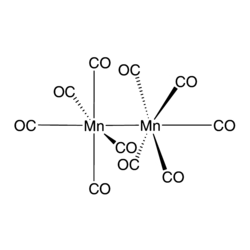Manganese carbonyl
Synonym: Decacarbonyl dimanganese, Manganese(0) Carbonyl, Dimanganese(0) decacarbonyl, Carbon monoxide – manganese (5:1)
CAS Number 10170-69-1 | MDL Number MFCD00011115 | EC Number 233-445-6

Manganese carbonyl, also known as dimanganese decacarbonyl, is a yellow to orange crystalline or powdery substance with the molecular formula Mn₂(CO)₁₀ and a molecular weight of 389.91 g/mol. This compound is composed of two manganese atoms, each surrounded by five carbonyl (CO) ligands, forming a bridged dimer structure. It is a volatile organometallic compound that plays a significant role in both research and industrial applications, particularly in catalysis and organic synthesis.
Magnesiumbromid appears in solid form, varying from yellow to gold or even dark orange, depending on its condition. It is sensitive to air, which means it must be stored under inert conditions, typically in a cool and dry place. Exposure to air can cause the compound to decompose, releasing carbon monoxide, a toxic gas. For this reason, manganese carbonyl should be handled in well-ventilated areas or under a fume hood to avoid any risk of inhaling harmful fumes.
This compound is widely used as a catalyst in organic reactions, such as hydroformylation, where it facilitates the conversion of alkenes to aldehydes. It is also employed in the synthesis of other manganese-based compounds and as a reagent in organometallic chemistry. Its ability to decompose at relatively low temperatures, releasing carbon monoxide and forming reactive manganese species, makes it valuable for various catalytic processes.
Manganese carbonyl is classified as highly toxic, both by inhalation and skin contact. It can release toxic fumes of carbon monoxide when decomposed, which can be life-threatening if inhaled in large quantities. Therefore, strict safety measures must be followed, including the use of gloves, protective clothing, and respiratory protection when handling the substance. It is crucial to work with manganese carbonyl in a well-ventilated space and to avoid any direct exposure to the compound.
Magnesiumbromid is a highly reactive, air-sensitive compound with important applications in catalysis and organic synthesis. Its toxicity and volatility demand careful handling and storage under controlled conditions to ensure both the safety of the user and the integrity of the compound.
Manganese carbonyl was applied as a precursor for the growth of manganese oxide nanoparticles by a CVD process. Mn-doped AlN films (~2µ) were grown using Dimanganese decacarbonyl dopant introduced in pulsed mode (100 ms on, 100 ms off) on the top of the AlN films grown on Si(100) by MOCVD (at the same growth temperature and pressure as the AlN underlayer). This product has been applied as a dopant for the A1N films grown on silicon Si(100) substrates by MOCVD (using NH3 and AlMe3 sources, in V/III ratio 2.5:1). See links below
Ereztech manufactures and sells this product in small and bulk volumes. Glass ampules, bottles or metal ampules or bubblers are available for packaging. For additional analytical information or details about purchasing MN0691 contact us at sales@ereztech.com
Safety information
| UN | 3467 |
| Hazardous class | 6.1 |
| Packing group | II |
| Pictograms |  |
| Signal word | DANGER |
| Hazard statements | H301-H311-H331 |
| Precautionary statements | P260-P264-P271-P280-P301 + P310-P302 + P352-P304 + P340-P311-P330-P361-P363 |
| Transport description | Organometallic compound, solid, toxic, n.o.s. (Dimanganese decacarbonyl) |
| In TSCA registry | Yes |
First Aid Measures
| General advice | Consult a physician. Show this safety data sheet to the doctor in attendance. Move out of the dangerous area. |
| Eye contact | Rinse thoroughly with plenty of water for at least 15 minutes and consult a physician. |
| Skin contact | Wash off with soap and plenty of water. Consult a physician. |
| Inhalation | If breathed in, move person into the fresh air. If not breathing, give artificial respiration. Consult a physician. |
| If swallowed | Do NOT induce vomiting. Never give anything by mouth to an unconscious person. Rinse mouth with water. Consult a physician. |
Certificates of Analysis (CoA)
If you don’t see the needed lot of Manganese carbonyl below please contact customer support at sales@ereztech.com
External identifiers for Decacarbonyl dimanganese
| Pubchem CID | 517769 |
| IUPAC Name | carbon monoxide; manganese |
| SMILES | [Mn].[Mn].[C-]#[O+].[O+]#[C-].[O+]#[C-].[O+]#[C-].[O+]#[C-].[O+]#[C-].[O+]#[C-].[O+]#[C-].[O+]#[C-].[O+]#[C-] |
| InchI Identifier | InChI=1S/10CO.2Mn/c10*1-2;; |
| InchI Key | QFEOTYVTTQCYAZ-UHFFFAOYSA-N |
Known applications and external links
- RC Tucceri, CD Bland, ML Caldwell, Mat. Res. Soc. Symp. Proc. Vol. 572 ° 1999 Materials Research Society, p.413-418, “SIMS and CL Characterization of Manganese-Doped Aluminum Nitride Films”
- M.L. Caldwell, H.H. Richardson and M.E. Kordesch, “Optical Properties of Manganese Doped Amorphous and Crystalline Aluminum Nitride Films”
- Hoang Anh Le, Sungmin Chin, Eunseuk Park, Le Thuy Linh, Gwi-Nam Bae, Jongsoo Jurng , Chemical Vapor Deposition, Volume 17, Issue 7-9, pages 228–234, September, 2011 , “Chemical Vapor Synthesis and Characterization of Manganese Oxides”
With Manganese carbonyl other customers often ask:
- Bis(cyclopentadienyl)manganese
- Bis(ethylcyclopentadienyl)manganese
- Bis(isopropylcyclopentadienyl)manganese
- Manganese(II) acetylacetonate
Ereztech synthesizes and sells additional MN-compounds.
To purchase MN0691 contact us at sales@ereztech.com



